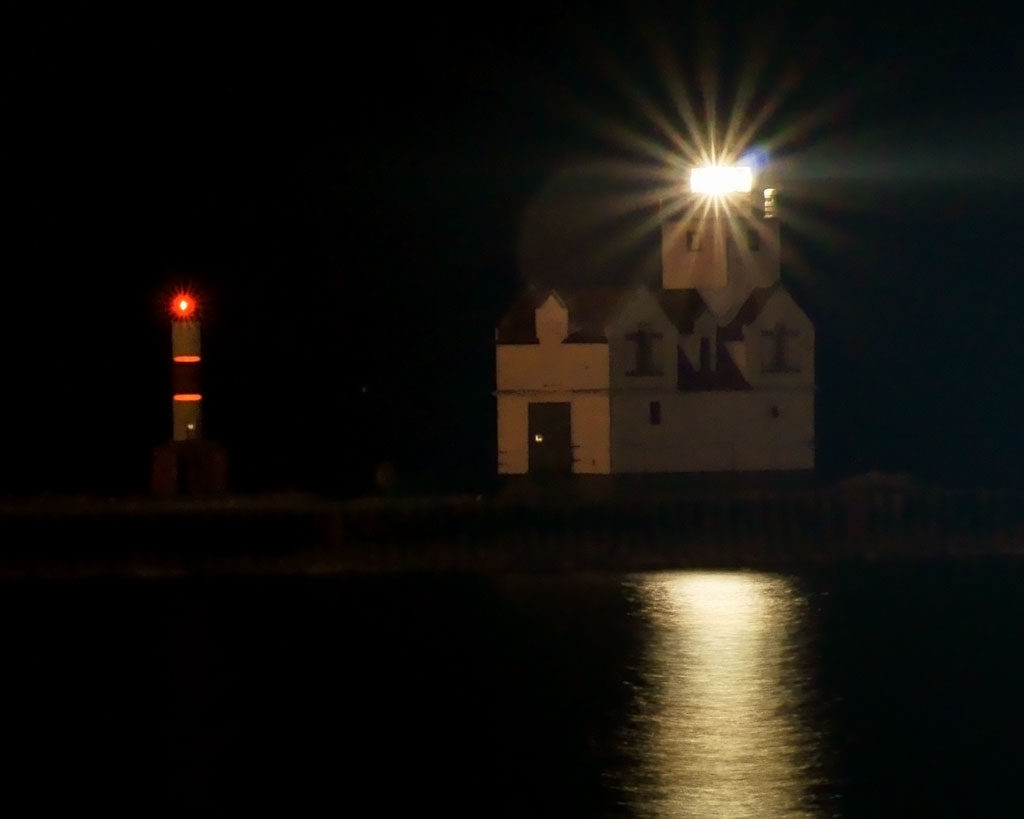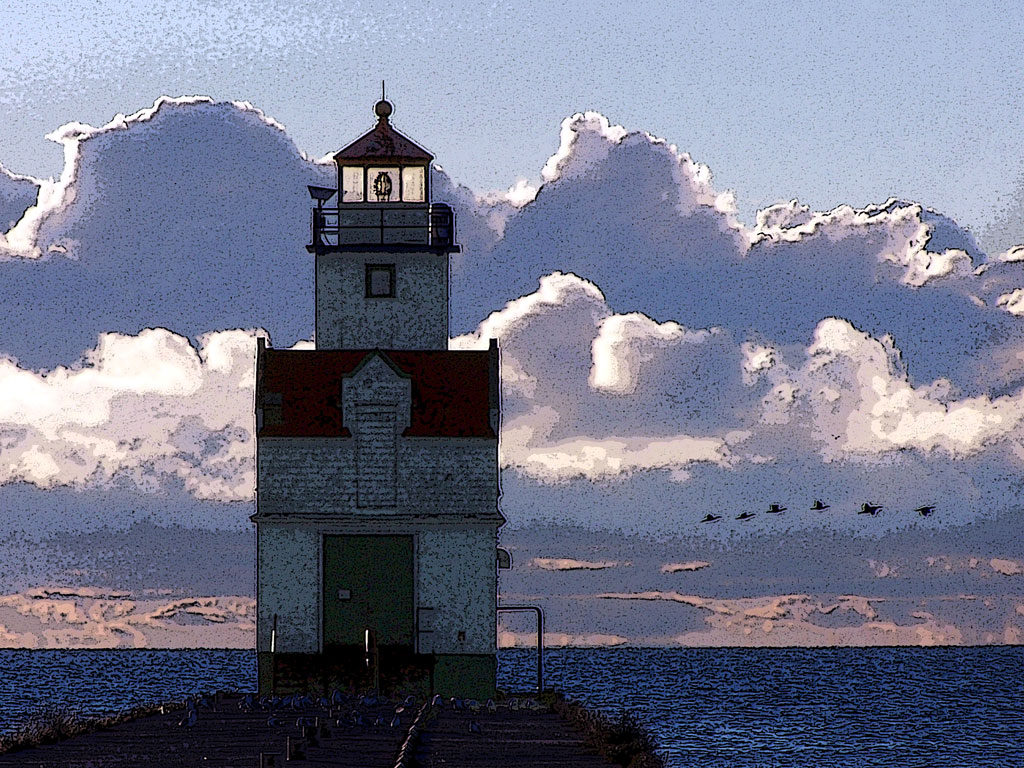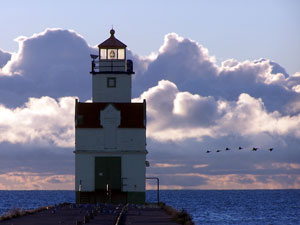Shining Star of Kewaunee
A night view of the Kewaunee, WI lighthouse – on the western shore of Lake Michigan.
A couple of weeks ago, I took a night photo of this same scene I entitled Kewaunee Night-House. There wasn’t much to see, because the lighthouse light overpowered the image.
I decided to try again. This time, in order to brighten the house and balance the bright light, I shined a 2,000,000 candle power spotlight on the lighthouse for about 10 seconds of a 30-second exposure.
This photo was taken from the parking lot of Kewaunee’s beach. I used a 300mm lens on my Sony SLT-A55 stabilized on a tripod inside the open side door of my Dodge Caravan.
I like this image better, but still feel there’s more work to do.
Winter Lighthouse – Algoma, WI
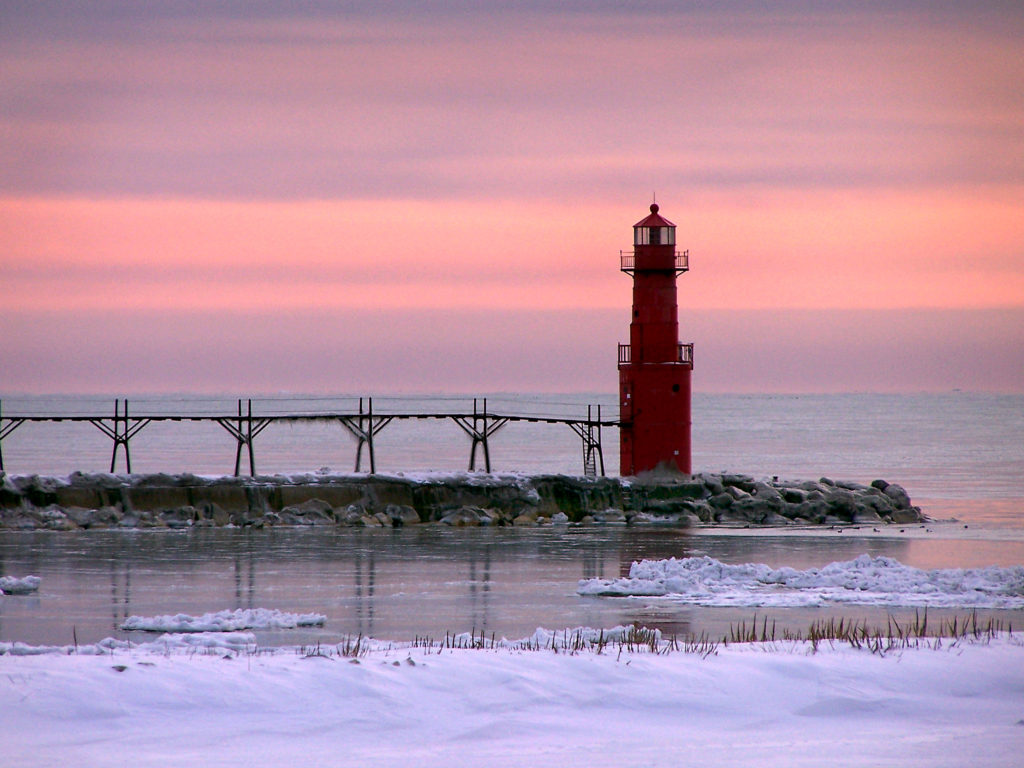
This is pier light at the entrance of the Algoma, WI harbor. This is a photo taken in March of 2007 using my old camera. That camera did some pretty good work.
(Clicking on the image will open a larger version.)
All of the photos I post are available for purchase. If you’d like to buy one, click on the blue “Buy this Online” bar below for a variety of print and frame options or contact me for digital purchase and licensing options.
![]()
Dear Pops – How To Buy a Camera
 Buying a camera can be difficult. There are a lot of sellers, brands, models, features and price points.
Buying a camera can be difficult. There are a lot of sellers, brands, models, features and price points.
Here’s a question from a Facebook friend…
Dear Pops,
I want to pick up a pocket camera. What kind do you recommend? I have an SLR digital camera already. I just want this for carrying along with me.
Julie
It would be hard for me to recommend a particular brand and model out of the hundreds of cameras available. People have varying wants, needs and budgets. What I can do, is tell you how I would go about choosing and buying a camera for myself.
The first thing I would do is take my time. Unless you have to buy a camera for some event tomorrow, give yourself some time to research and shop. The camera you buy will likely be with your for, at least, a couple of years. The right choice will yield great photos and lasting memories. The wrong choice will only frustrate you and end up on a shelf in the back of a closet.
If I were looking for a new camera, I’d start shopping around. Visit a few stores, watch the sale flyers, browse your favorite online retailers. Get an idea for whats out there.
While you’re shopping, compare common digital camera features and begin to make a list of what you want/need a camera to have.
Important considerations for a digital camera I might buy:
Batteries
Am I going to be buying AAs or AAAs or does it have its own rechargeable battery pack? I prefer the rechargeable battery pack. I’d also like to know how long the batteries it uses will last before having to be replaced/recharged. Manufacturers sometimes rate battery life by the number of pictures you should get on a fresh battery. I’d reduce their estimate by a third.
Lens
On an inexpensive, point-and-shoot camera, you’re not going to get a high quality lens, but you still want as good as you can get. Every image has to pass through that lens to get to the camera’s sensor. You also need to decide if zoom is important to you. When shopping for zoom, only give consideration to “optical zoom.” “Digital Zoom” is a marketing gimmick and virtually useless to a photographer. Digital zoom simply crops the image; something better done with your photo editing software.
Memory
I prefer a camera that uses SD cards because my computer accepts them. Other types of memory media are fine, as long as its compatible with the card reader you will use to download images. Many cameras don’t need a card reader; you simply plug in a USB cord to download the images to your computer. When you buy the camera, be sure to buy enough memory for the number of photos you might take in a single outing.
Brand
I would be looking for a major brand-name camera. There are plenty no-name cameras that entice you with a long list of features at low prices. They rarely deliver on the promises boldly printed on the package. Pick a camera from a company with a reputation for good cameras. Of course, you could always gamble and maybe you’ll get lucky…or not.
Reviews
After you’ve done your research and found a camera that offers the features you want at a price you’re willing to pay, look for detailed reviews. There are people who know a lot more about cameras than I do – with the expertise and tools to uncover the good, bad and ugly of any digital camera. Before I’d buy any camera, I would look at the reviews offered by independent experts. I’m not interested in reviews that simply serve up the manufacturer’s marketing materials. I want unbiased, detailed testing and review. Three sites I like are www.dpreview.com, www.imaging-resource.com, and www.digitalcamerareview.com. (There are plenty of others on the web.) Go to these sites and type a camera brand and model into the search box, and you’ll likely get a full review, complete with image samples. You can also look for cameras they recommend in the price range your interested in. When trying to choose between a couple of different models, these sites can help you compare them side-by-side.
Owner Ratings
My final step is to look at what actual users are saying about the camera. I like going to Amazon.com because of their Customer Reviews. I’ll look at the ratings and some of the experiences customers share. You can learn quite a bit from someone else’s hands-on, real-world experience.
If I were in the market for a new camera, that’s the approach I’d take. In fact, when I was ready to upgrade from my 5-year-old Kodak a few months ago, I went through this process. I hadn’t been in the camera market for 5 years, so I had to educate myself. I looked at a number of cameras and narrowed it down to three – a Canon, a Nikon and a Sony. There’s no way I could have made the best choice just by browsing the electronics department of a discount store for a good price. On a store shelf, they all look good; they’re all on sale. The Sony I bought (and love) wasn’t even available at the local retail outlets I shopped.
If you have some camera buying tips or suggestions for Julie, feel free to comment below.
Happy shopping!
Pops Quick Tip – Take More Shots
With a digital camera, you can take as many pictures as your camera’s memory card can hold. That’s the beauty of digital photography. Once you own the equipment, it doesn’t cost anymore to take a dozen pictures than it does to take one. So, take advantage of the creative equity stored in your camera and take a lot of shots.
Another great advantage of digital photography is the instant feedback of an LCD screen. With traditional film, you wouldn’t know what you had until you used up the roll, sent it to be developed and picked up your packet of prints – a process that could take weeks or months. Now, with the click of a shutter, you can see the image you shot…kinda. That 2 or 3 inch screen can be deceptive. What looks pretty good on your camera’s screen, might be a mess on your computer screen. Another shot or two of the same subject increases the likelihood of capturing the image you really want.
When I can, I try to take several shots (and sometimes a great deal more) of each photo I’m after. Taking more pictures gives me the opportunity to vary settings and try different techniques. With people, eyes blink and the nuance of expression morphs continually. The more pictures I take, the more I have to select from and the greater my chances of getting an extraordinary final product.
 Honestly, I’m not as good a photographer as some people might think. A great photographer could take a few shots and most of them would impress you. On the other hand, I can take a couple of hundred and only produce a few I feel are worth keeping. As I become more familiar with my camera and develop my knowledge and skill, my ratio of keepers will increase.
Honestly, I’m not as good a photographer as some people might think. A great photographer could take a few shots and most of them would impress you. On the other hand, I can take a couple of hundred and only produce a few I feel are worth keeping. As I become more familiar with my camera and develop my knowledge and skill, my ratio of keepers will increase.
I’m not suggesting you simply fire off hundreds of shots like a 9-year-old with a submachine gun, thinking the spray of bullets is bound to hit something…eventually. Be a thinking photographer. Think of a different approach, a unique angle, experiment with depth of field, play with the fill flash, vary exposure, fiddle with filters, etc.
One of my favorite quotes, attibuted to a number of people – from Thomas Jefferson to Samuel Goldwin – is, “The harder I work, the luckier I get.”
We can apply that same concept to the art of digital photography: The more photos we take, the more masterpieces we’ll find.
White Bench on a Winter Beach
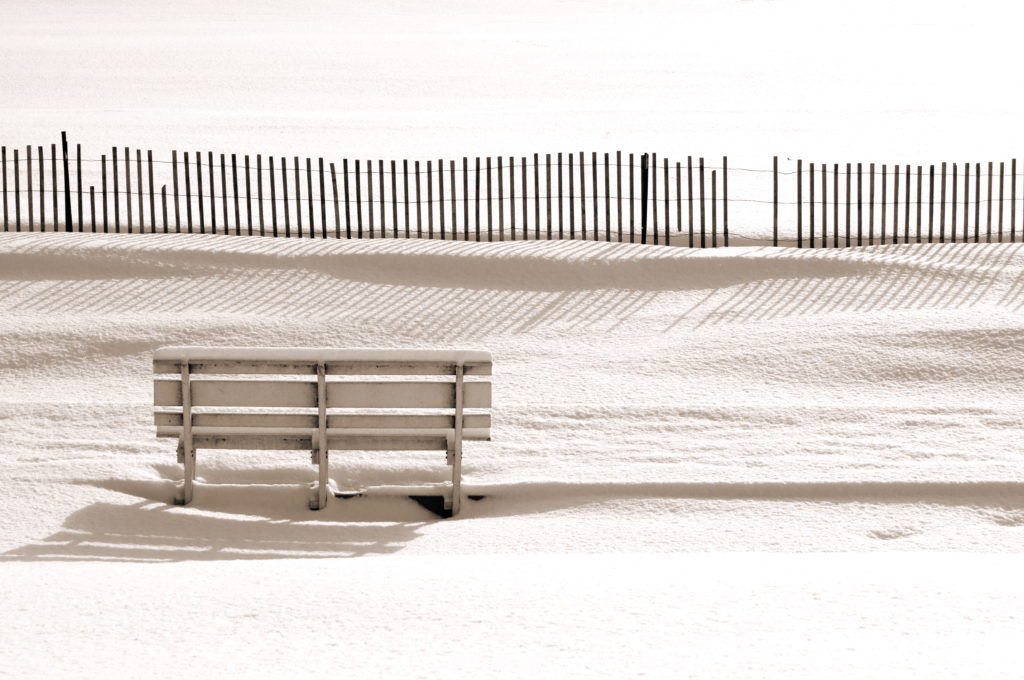
Last Saturday I stopped at Crescent Beach in Algoma, WI and snapped this image. Beyond the fence and out of view is the open water of Lake Michigan.
I took several shots – with the sun shining brightly and with the sun behind the clouds. I preferred the bright sun (as seen here) to emphasize the contrast of the shadows on the snow.
After downloading to my computer, I added the sepia tone in Photoshop.
Spring’s First

Miserable weather this week – beginning with snow, blustery winds and bitter cold – have me thinking of spring.
Instead of posting the photo of a snow scene snapped last Saturday, I thought something a little more optimistic would be a better choice today.
These are some early blooming wildflowers I captured on a hike through the woods of a state park near Sturgeon Bay, WI.
The simplicity and the colors of this image make it one of my favorites.
Pops Quick Tip – Keep Your Camera Close
 I can’t tell you how many times I’ve felt like kicking myself when I missed a great shot because I didn’t have my camera with me. (Sorry, that cell phone camera doesn’t cut it.)
I can’t tell you how many times I’ve felt like kicking myself when I missed a great shot because I didn’t have my camera with me. (Sorry, that cell phone camera doesn’t cut it.)
Life and light are happening all around you. If you keep your camera close you’ll be ready when you stumble along breathtaking beauty…when artistic inspiration grips you…when the unusual, never-to-be-repeated event occurs.
I’m making a concerted effort to keep my camera with me. I haul it around, along with a variety of other basic gear, in a good case. Many days I carry it around and never take it out of the case; but I’ve got it should I need it. (Lately, my greatest challenge is pausing from the rat race long enough to snap a few frames.)
The number of interesting images that populate my camera’s memory card tends to have a direct correlation to the amount of time I spend with my camera. Great photo ops are popping up all the time – you might as well capture them.
Keep your camera close!
Between a Rock and a Calm Place

This is an early morning edition of the pier light that marks the harbor entrance at Algoma, WI.
If you follow this blog, you’ll notice it’s one of my favorite subjects.
Cloud Bank Background
When I take photos, I usually take a lot. Then I load them on to my computer and pick out one or two that I like and share them. All the other images from that day are still on my computer. When things are slow – photography wise – I’ll look through some of those photos I passed on the first time around and see if there’s something worth bringing out.
This photograph is one taken in 2009 using my old Kodak EasyShare DX7590. It is the Kewaunee Lighthouse. The lighthouse is actually a supporting actor. I think the clouds are the real star and makes this image a keeper for me. The flock of birds provide a nice accent.
As I often do with photos that don’t quite dazzle me on their own, I added a digital effect to this one using a Photoshop filter.
Feel free to leave a comment.
Dear Pops – Answering Common Digital Photography Questions.
I wouldn’t consider myself an expert, but I know my way around a digital camera. Every now and then, someone who has seen my photos will come to me with questions about how to improve their own images. Now that I have this photography blog, I can post the answers here so that… (1) other photographers can pick up a pointer or two, and… (2) other’s who have overcome the same issues can post “Comments” below with their own suggestions and solutions. (Lord knows, I don’t have all the answers.)
Here’s a question I received by email this week. Rob wrote looking for advice with a common, frustrating problem.
Hi Pops Digital,
I have a photography problem Ive been trying to figure out for some time. looking at some of your photos, you seem to know a little. I was wondering if you could give me some advice.
I have a Canon G10 camera. It’s a point-and-shoot model but has many features of an SLR camera. My question is about something that’s been really frustrating me when I take photos during my kids basketball games. When I take a picture it is always dark. I think it has something to do with the gym being so large and well lit. When I use the flash it somehow darkens the picture. When I turn the flash off, the picture is brighter but now I run into blur. Ive tried messing with increasing the shutter speed but the pictures still didn’t turn out well. Do I need some type of zoom lens to get better results or am I just not hitting the right combination of settings? I’m confused.
Thanks for any advice,
Rob
I did some quick research on his camera and sent back this reply…
Rob,
I checked on your camera and saw that, in it’s day, it was a highly recommended model. Good choice.
The problems you are having are a combination of lighting conditions and camera limitations. Action/sports photography is a difficult trick to pull off, even with a great camera and good conditions.
The first limitation to address is the flash. Most point-and-shoot cameras have an effective flash range of less than 15 feet. So, unless you are right on top of the action, the flash will not help you. The reason the picture seems to darken when you use the flash is because your camera automatically adjusts its settings for proper exposure with flash. However, its settings are based on your subject being within its flash range. Even a well lit room is not as bright as the light from your flash at 15 feet…so anything beyond the flash range will seem dark, if it shows up at all.
When you turn off the flash, your camera measures the available light in the room and adjusts its settings for the best exposure. Unless you are in an extremely bright room, the shutter speed will be slowed down enough that anything with quick movement – like a basketball game – will likely be blurred.
Adding some type of zoom lens would only compound the problems you are having. Zoom lenses typically require more light, which would slow down the shutter speed even more. And zooming in doesn’t just magnify the subject of your photograph, it also magnifies any camera movement…creating more opportunity for blurring the image.
Since I don’t know how you had your camera set, it’s possible tweaking the settings could help, but I honestly doubt that your camera has the ability to give you quality, sports shots indoors. Increasing the shutter speed could help to eliminate blur, but you wouldn’t have enough light to see the subject in a typical school gym at a shutter speed fast enough to stop the action.
Honestly, most point and shoot cameras don’t have the ability to do what you are asking; and do it well. Even newer models.
The Canon G1 has been around since 2000. My best advice would be to upgrade to a newer model. You’ll find that newer cameras have dramatically improved low light capabilities. For less than $250 (and possibly much less) you would see amazing results. (Keeping in mind, you are still asking the camera to do a very difficult task.)
If a new camera is not in the budget right now, you might still be able to get a decent shot with your G1 if you position yourself just out of bounds near the basket and took pictures when the kids are close – within the range of your camera’s flash. Give it a try and share any photos that turn out well.
Happy shooting,
Pops Digital
If you have any ideas or suggestions that might help Rob, please share them as comments, below. If you have some other digital photography question, write your own “Dear Pops” letter and watch this blog for the answer.



















































